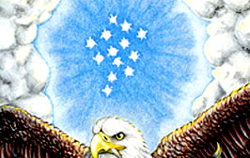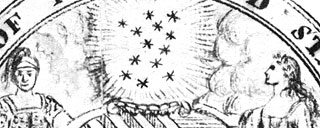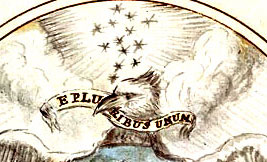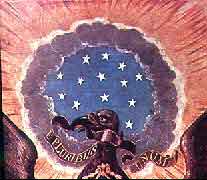Constellation of Thirteen Stars
on the Great Seal of the United States

The description of the Great Seal devotes one of its three paragraphs to the "Crest" over the head of the eagle: "Thirteen stars forming a Constellation,"


A "radiant constellation" was the idea of Francis Hopkinson, the consultant on the second committee (1780) who three years earlier had suggested the stars and stripes for the American flag. His sketch (above) shows the stars in a random formation with clouds nearby.
 For the final Great Seal, Charles Thomson placed the constellation of 13 stars over the head of an American bald eagle (right). And he specified that rays of light are "breaking through a cloud."
For the final Great Seal, Charles Thomson placed the constellation of 13 stars over the head of an American bald eagle (right). And he specified that rays of light are "breaking through a cloud."
The shape of individual stars is not mentioned in the written description that defines the Great Seal's appearance. In both these sketches, stars are indicated by asterisks. There is no intended symbolic significance to the number of points a star has. An artist can depict them with five, six, or more points.
Thomson said the "constellation denotes a new State
taking its place and rank among other sovereign powers."

The shape of the constellation is also not specified. Both preliminary sketches show the stars in a random arrangement, and according to the laws or heraldry, they should be natural – not shaped into a pattern – whether a hexagram, a dollar sign, a heart, or other recognizable image.
The essential principles of our Government form "the bright constellation which has gone before us and guided our steps." – Thomas Jefferson
 Early realizations of the Great Seal correctly depicted the constellation of stars in a natural random arrangement. Shown here is the crest of the first painting of the Great Seal.
Early realizations of the Great Seal correctly depicted the constellation of stars in a natural random arrangement. Shown here is the crest of the first painting of the Great Seal.
Very accurate versions of the Great Seal are on the Indian Peace Medals given by President Washington.
U.S. government versions of the Great Seal show the constellation of 13 stars in a hexagram pattern (two triangles intersecting to form a six-pointed star). There has been much speculation about the symbolic intent of this hexagram, but it may have been simply a rearrangement of the 13 stars on the first American flag.
|
Origin of the Crest
The word "crest" comes from cresta, Latin for the tuft or comb upon the head of many birds. A crest was placed on top of the helmet of chieftains so their followers could easily identify them in battle. They were usually the figure of some animal or bird and made the wearer seem taller and more imposing.
Alexander the Great adapted the ram's head. Julius Caesar was known by a star, the head of a bull, an elephant, or the she-wolf that suckled Romulus and Remus.
Crests evolved from such ferocious animals intended to represent the bearer and his pursuits. They became devices to perpetuate tradition and family legends, often complementing symbols on the shield.
|
| 
